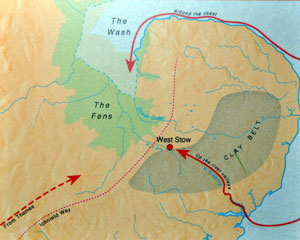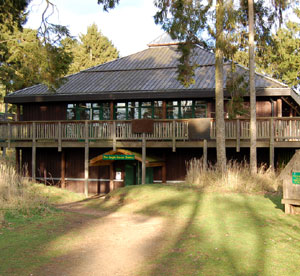
This commemorative plaque for the formal opening ceremony stands at the entrance to the Anglo-Saxon Centre. |

Also outside the Centre is this plan of the Village and its field layout as it might have been in its heyday in the 6th century. |

Lobby and entrance to the Anglo-Saxon Centre Exhibition. |

Anglo-Saxon Centre Exhibition Gallery Plan. |

Showing the first four "timeslots" illustrated in the gallery. |

Showing the second four "timeslots" illustrated in the gallery. |

Description of Stone Age occupiers of the site. Mesolithic hunters visited some 6,000 years ago. Centuries later it was a neolithic burial site. |

Neolithic objects found here. These cover the years from 5,000 BC to 2,500 BC. Top is a flaked flint axe. Below is a polished flint axe, and at the bottom is a neolithic broken axehead found in an Anglo-Saxon house, number 18. Presumably it was still an object of interest, as it was made of imported Cornish greenstone. |

Description of Iron Age occupiers of the site. In the time 300 BC to AD 60 there was a farmstead here of circular buildings, probably of people we call Iceni.
Some 20 years later under now established Roman control, in AD 80 a pottery industry began here using local clay, with up to ten kilns on site. The pottery here was produced under Roman rule by Romano-British potters. By about AD 150 the industry petered out. |

Iron age pottery found on site. On the left is a typical Iron Age Phase II object from 1st century BC to 1st century AD. Typically hand made jars and bowls with rounded shapes and developing bases. On the right is an Iron Age phase III pot from the first half of the 1st century AD up to c 60 AD. |

Pottery produced here over 70 years during the Roman period up to AD 150. Decorations become more complex, and samian ware becomes the colour of high status pottery. |

Description of Roman Age occupiers of the site. By about 375 there was a flourishing Roman centre at nearby Icklingham, just behind Rampart Field. Forts of the Saxon shore were the Roman answer to Saxon pirate raids on the east coast. |

The Roman empire withdrew all its troops from Britain in 410 AD. In the next 25 years the first Saxon settlers arrived. Possible routes by which the Anglo-Saxons arrived at West Stow are shown here. |

View of the Anglo-Saxon Centre Exhibition. |

Links with their homelands were maintained subject to difficulties in travel. This is a diagram to show the extensive trade links available to local Anglo-Saxons. Seas and rivers were their major highways. |


